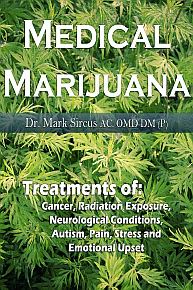“When his cancer came back for a fifth time, Michael McShane was desperate for treatment outside of traditional medicine.
The last time squamous cell carcinoma left lumpy tumors around his mouth, doctors cut it away and reconstructed his bottom lip by turning out a portion of its inner layer.
“You can only do most facial tricks once,” McShane, 51, said. “I needed another option.”
As a qualifying medical marijuana patient, he tried “Simpson oil” derived from cannabis plants by a Canadian named Rick Simpson. McShane bought some from an Oak Park dispensary that has since closed and puts a few drops every day on his face. Over the course of about 10 weeks, the tumors faded and then seemed to disappear.
His dermatologist, Ali Moiin, M.D., has said McShane isn’t cured but his cancer cells have decreased by about 60 percent.
“You still have some residual ones, but the size has definitely decreased,” Dr. Moiin told a WWJ reporter in late August, adding he thinks the results merit further scientific study.
Moiin didn’t return phone calls for an interview for this story. He isn’t the doctor who signed the physician certification form for McShane, who has another qualifying medical problem.
In all, since the Michigan Medical Marijuana Program started in April 2009, 2,215 of the state’s licensed physicians have certified that a patient suffers from one of the debilitating conditions identified in the act, and that the patient may find therapeutic and palliative relief from the medical use of marijuana. A total of 105,458 patient registry cards have been issued in that time period.
An estimated 55 doctors signed 70 percent of the certification forms, according to one review; most of the others aren’t talking about it publicly.
“I imagine it is a fairly sensitive issue because it is politically charged,” said Colin Ford, director of state and federal government relations for the Michigan State Medical Society.
Physicians are cautious because patient privacy is important, he said.
A forbidden cure?
Privacy isn’t as important to McShane as sharing what he considers his latest triumph over cancer without surgery, radiation, chemotherapy, reconstructive surgery and their side effects.
“The marijuana oil replaced all that and reduced the cancer to almost nothing,” he said. “My forehead and mouth were in bad shape in the spring. All of a sudden one morning it was there — a callous-like growth the size of a half dollar on my forehead. Skin cancer is my regular nemesis.”
McShane is one of a growing number of people extolling the healing properties of Simpson oil for everything from cancer, AIDS, Crohn’s disease, osteoporosis, arthritis, and diabetes to psoriasis, hemorrhoids and warts. They call it a “forbidden cure,” saying the oil that can be used topically or ingested isn’t given enough credit because it would cut into medical and pharmaceutical profits.”
By Catherine Kavanaugh
Daily Tribune Staff Writer
Video: http://www.youtube.com/watch?v=gr8RPjrsYSI



